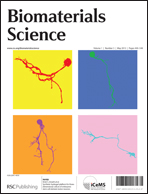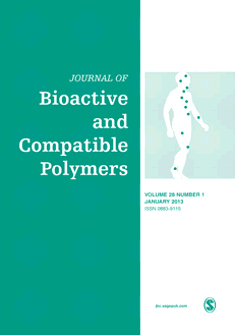
Biomaterials Science
Scope & Guideline
Empowering researchers to shape the future of biomaterials.
Introduction
Aims and Scopes
- Tissue Engineering and Regenerative Medicine:
Research in this area includes the development of scaffolds, hydrogels, and other materials that promote tissue regeneration and repair, often incorporating growth factors and bioactive molecules. - Drug Delivery Systems:
The journal covers the design and characterization of nanoparticles, liposomes, and hydrogels for targeted and controlled delivery of therapeutic agents, including chemotherapeutics and biologics. - Nanotechnology in Biomedicine:
Publications focus on the synthesis and application of nanomaterials, including quantum dots, metal-organic frameworks, and nanocomposites for imaging, diagnostics, and therapy. - Smart and Responsive Biomaterials:
Research on materials that respond to environmental stimuli (e.g., pH, temperature, light) for applications in drug delivery, wound healing, and cancer therapy. - Biomaterials for Infection Control:
This area emphasizes the development of antimicrobial coatings, hydrogels, and other materials designed to prevent or treat infections, particularly in surgical and implant scenarios. - Biocompatibility and Safety Evaluation:
Studies assessing the biocompatibility, toxicity, and long-term stability of biomaterials in vivo, ensuring safety for clinical applications.
Trending and Emerging
- Personalized Medicine and Targeted Therapies:
There is a growing emphasis on developing personalized therapeutic solutions using biomaterials, especially for cancer treatment, where targeted drug delivery systems are being tailored to individual patient profiles. - 3D Bioprinting and Tissue Models:
Research in 3D bioprinting technologies and the creation of complex tissue models is rapidly increasing, highlighting the potential for innovative therapeutic applications and disease modeling. - Micro and Nano-Scale Systems:
The emergence of micro and nano-scale biomaterials for applications in diagnostics, targeted drug delivery, and regenerative medicine reflects a trend towards miniaturization and precision medicine. - Biomaterial-Cell Interactions:
Enhanced understanding of how biomaterials interact with cells, including the modulation of immune responses and cellular behavior, is a significant focus area, particularly in the context of tissue engineering. - Sustainable and Green Biomaterials:
The development of environmentally friendly biomaterials derived from renewable resources is gaining traction, reflecting a broader trend towards sustainability in material science. - Smart Biomaterials with Responsive Functions:
Research is increasingly focused on materials that can respond dynamically to environmental changes (e.g., pH, temperature), allowing for advanced applications in drug delivery and tissue engineering.
Declining or Waning
- Traditional Biomaterials:
Research on conventional materials like metals and ceramics for implants is decreasing as newer biomaterials, particularly bioactive and smart materials, gain attention. - Basic Polymer Studies:
There is a noticeable decline in studies focused solely on the synthesis and characterization of basic polymers without clear applications, as the field shifts towards more applied research. - Generalized Drug Delivery Systems:
Research that does not specify targeting mechanisms or novel delivery strategies is becoming less prominent, with a trend towards more specialized and targeted approaches.
Similar Journals

Progress in Biomaterials
Pioneering Research for a Sustainable TomorrowProgress in Biomaterials is a premier journal published by Springer Heidelberg, dedicated to advancing the field of biomaterials through the dissemination of high-quality research articles, reviews, and case studies. The journal, with an ISSN of 2194-0509 and an E-ISSN of 2194-0517, holds an esteemed position within both the Biomaterials and Chemical Engineering fields, as evidenced by its rankings in the Q2 and Q1 quartiles, respectively. With its convergence over the years from 2013 to 2023, it has maintained a strong impact on scientific discourse, ranking #15 in Chemical Engineering and #30 in Biomaterials according to Scopus metrics. The journal is based in Heidelberg, Germany, and aims to provide an open platform for interdisciplinary collaboration amongst researchers, professionals, and students alike, fostering innovation and progress in biomaterials research. As a crucial resource for those engaged in this dynamic field, it empowers authors and readers to explore the latest trends, technologies, and applications in biomaterials development.

Asian Journal of Pharmaceutical Sciences
Advancing pharmaceutical knowledge for a healthier tomorrow.Asian Journal of Pharmaceutical Sciences is a prestigious open-access journal published by Shenyang Pharmaceutical University, dedicated to advancing research and developments in the field of pharmaceutical sciences. Since its inception in 2009, the journal has successfully converged a wealth of knowledge and innovation, demonstrating an impressive track record with its open access model adopted in 2013, ensuring global dissemination of crucial research findings. With an outstanding impact factor and consistently ranked in the Q1 category for both Pharmaceutical Science and Pharmacology in 2023, it ranks among the top journals in its field, as evidenced by its impressive Scopus rankings—4th out of 183 in Pharmaceutical Science and 10th out of 313 in Pharmacology, showcasing its high relevance and credibility (98th and 96th percentiles respectively). Researchers, professionals, and students can access a diverse array of articles that encompass groundbreaking studies, reviews, and reports, solidifying the journal's position as a vital resource for anyone engaged in pharmaceutical research. With its commitment to quality and accessibility, Asian Journal of Pharmaceutical Sciences plays an essential role in fostering innovation and collaboration within the global scientific community.

Biomedical Materials
Transforming Science into Life-Saving Solutions.Biomedical Materials, published by IOP Publishing Ltd, is a premier journal dedicated to the rapidly evolving field of biomedical engineering and materials science. With a robust impact factor showcasing its influence, this journal serves as a vital platform for disseminating pioneering research from 2006 to 2024. Covering an array of interdisciplinary topics—ranging from biomaterials to bioengineering and applied chemistry—the journal consistently ranks in the second quartile across multiple categories including Bioengineering (Q2), Biomaterials (Q2), and Biomedical Engineering (Q2) as of 2023. Researchers, professionals, and students alike benefit from its contributions, exploring innovative solutions at the intersection of biology and material science. Although not an Open Access journal, Biomedical Materials remains essential in advancing our understanding and facilitating discussions surrounding state-of-the-art materials that revolutionize medical applications and enhance patient care.

ACS Biomaterials Science & Engineering
Connecting Research and Application for a Healthier TomorrowACS Biomaterials Science & Engineering, published by the American Chemical Society, serves as a premier platform for the latest advancements and research in the fields of biomaterials and biomedical engineering. With an impressive impact factor and a strong reputation reflected in its ranking—Q2 in Biomaterials and Q1 in Biomedical Engineering—the journal attracts a diverse and engaged readership. Since its inception in 2015, it has aimed to foster innovation by publishing high-quality research articles, reviews, and perspectives on the synthesis, characterization, and application of biomaterials. Researchers and professionals benefit from the journal's rigorous peer-review process and its focus on translational science, making it essential for those looking to stay at the forefront of biomaterials research. Located in Washington, DC, USA, the journal plays a pivotal role in connecting academic and industrial sectors, ultimately driving advancements that impact biomedicine and related fields.

JOURNAL OF BIOMEDICAL MATERIALS RESEARCH PART B-APPLIED BIOMATERIALS
Connecting Material Science and Medicine for a Healthier FutureJOURNAL OF BIOMEDICAL MATERIALS RESEARCH PART B-APPLIED BIOMATERIALS, published by Wiley, is a leading journal in the field of biomaterials and biomedical engineering, with an impact factor reflected in its relevant Scopus rankings—including a Q2 position in Biomedical Engineering and Q3 in Biomaterials for 2023. This journal, with ISSN 1552-4973 and E-ISSN 1552-4981, serves as a vital platform for disseminating pioneering research and innovative applications of biomaterials. Positioned in the United States, it aims to bridge the gap between material science and biological applications, fostering collaboration among researchers, professionals, and students dedicated to advancing technology in healthcare. With a convergence of studies from 2003 to 2024 and a growing focus on open access, the journal ensures greater visibility and accessibility for groundbreaking research. Join us in exploring the dynamic field of biomaterials, as we push the boundaries of science and engineering for improved patient outcomes.

JOURNAL OF BIOACTIVE AND COMPATIBLE POLYMERS
Bridging Disciplines in Polymer ResearchJOURNAL OF BIOACTIVE AND COMPATIBLE POLYMERS, published by SAGE PUBLICATIONS LTD, serves as a pivotal platform for disseminating innovative research in the fields of bioengineering, biomaterials, materials chemistry, and polymers. With an ISSN of 0883-9115 and an E-ISSN of 1530-8030, this journal is committed to the advancement of knowledge relating to the interaction of polymers within biological systems and their compatibility in various applications. Operating since 1986, the journal has garnered a respectable presence, ranked in the Q3 quartile across multiple categories in 2023, indicating its relevance and contribution to these dynamic fields. Although not open access, the journal ensures that high-quality research is accessible to subscribers and institutions, reinforcing its importance for researchers, professionals, and students aiming to stay abreast of advancements in polymer science and biocompatibility. By fostering interdisciplinary communication and collaboration, the JOURNAL OF BIOACTIVE AND COMPATIBLE POLYMERS continues to play a crucial role in shaping the future of material applications in health, technology, and industry.

Biomaterials Advances
Bridging Science and Application in Biomaterials AdvancesBiomaterials Advances is a premier journal published by Elsevier, dedicated to the rapidly evolving field of biomaterials. Established in the United Kingdom, this open-access journal aims to disseminate high-quality, peer-reviewed research that explores innovative biomaterial designs and their applications in bioengineering and biomedical engineering. With an impressive 2023 impact factor reflected in its Q1 rankings across multiple categories—including Bioengineering, Biomaterials, and Biomedical Engineering—Biomaterials Advances stands out as a critical platform for scholars and practitioners faced with advancing technologies and methodologies in the realm of materials science. Covering a broad range of topics, from biocompatibility to tissue engineering, this journal provides an inclusive forum for researchers seeking to contribute to the field. Its Scopus rankings further affirm its position as a leading resource, with notable standings in Biomedical Engineering (Rank #13), Biomaterials (Rank #8), and Bioengineering (Rank #11), all within the top percentiles. Researchers and students alike are encouraged to contribute and engage with the latest findings and innovations in biomaterials through this valuable publication.

Gels is a distinguished, peer-reviewed journal published by MDPI, focusing on the innovative field of gels and their myriad applications across disciplines such as bioengineering, biomaterials, and organic chemistry. Since its inception in 2015, this Open Access journal has provided a platform for researchers to disseminate cutting-edge findings, enabling wider visibility and impact for their work. Based in Switzerland, Gels has firmly established itself within the academic community, achieving notable recognition as evidenced by its recent Q1 ranking in Polymers and Plastics, and multiple Q2 placements in related categories, demonstrating its relevance and importance in the field. The journal serves as a vital resource for professionals and scholars aiming to engage with the rapidly evolving research landscape surrounding gel technologies, making significant contributions to sustainable materials, drug delivery systems, and much more. With its commitment to Open Access, Gels ensures that research findings are readily accessible to all stakeholders, fostering collaboration and advancement in science and engineering fields.

Journal of Tissue Engineering and Regenerative Medicine
Bridging engineering and medicine for transformative health.Journal of Tissue Engineering and Regenerative Medicine, published by WILEY, stands as a pivotal platform in the fields of biomaterials, biomedical engineering, and regenerative medicine. With an ISSN of 1932-6254 and an E-ISSN of 1932-7005, this journal, based in the United Kingdom, has consistently delivered high-quality research since its inception in 2006, converging critical insights through 2024. With an impressive citation profile reflected in its Scopus rankings—specifically a rank of #58 in Medicine and #75 in Biomedical Engineering—the journal is acknowledged for its substantial impact, as demonstrated by its competitive quartile standings in 2023. Notably, it maintains a Q3 ranking in Biomaterials and Q2 in both Biomedical Engineering and Medicine (miscellaneous), showcasing its influence and relevance in the rapidly evolving interplay between engineering and medicine. The journal serves as a vital resource for researchers and practitioners aiming to stay abreast of innovations and breakthroughs in regenerative therapies, tissue scaffolds, and biomaterials. While not an open-access publication, it fosters academic dialogue and knowledge dissemination that is crucial for advancing the field.

BIOMATERIALS
Illuminating the Path to Next-Gen BiomaterialsBIOMATERIALS, published by Elsevier Science Ltd, is a premier academic journal dedicated to the interdisciplinary field of biomaterials research. With an impressive impact factor, it ranks in the Q1 quartile across multiple categories including Bioengineering, Biomaterials, and Biophysics, showcasing its significance in advancing scientific knowledge. Established in 1980 and set to converge its discussions through 2025, this journal provides a critical platform for researchers and professionals to disseminate their findings on the development, application, and performance of biomaterials. The journal covers a wide range of topics, from the mechanics of materials to nanotechnology, and is highly regarded with top Scopus rankings in essential categories, including an exceptional position within the 99th percentile for Biophysics. Although not an open access journal, BIOMATERIALS remains vital for students and established researchers alike, ensuring accessibility to groundbreaking research in the field. Engage with cutting-edge studies that pave the way for innovative applications in medicine, engineering, and beyond.